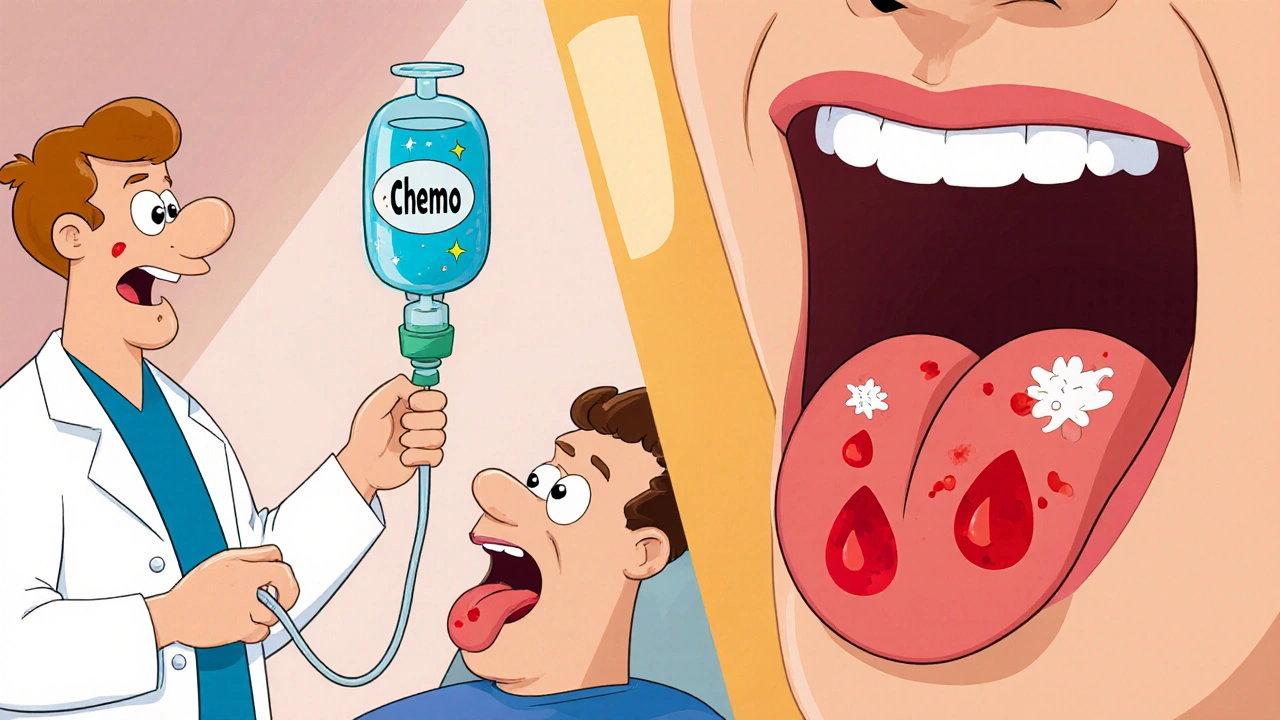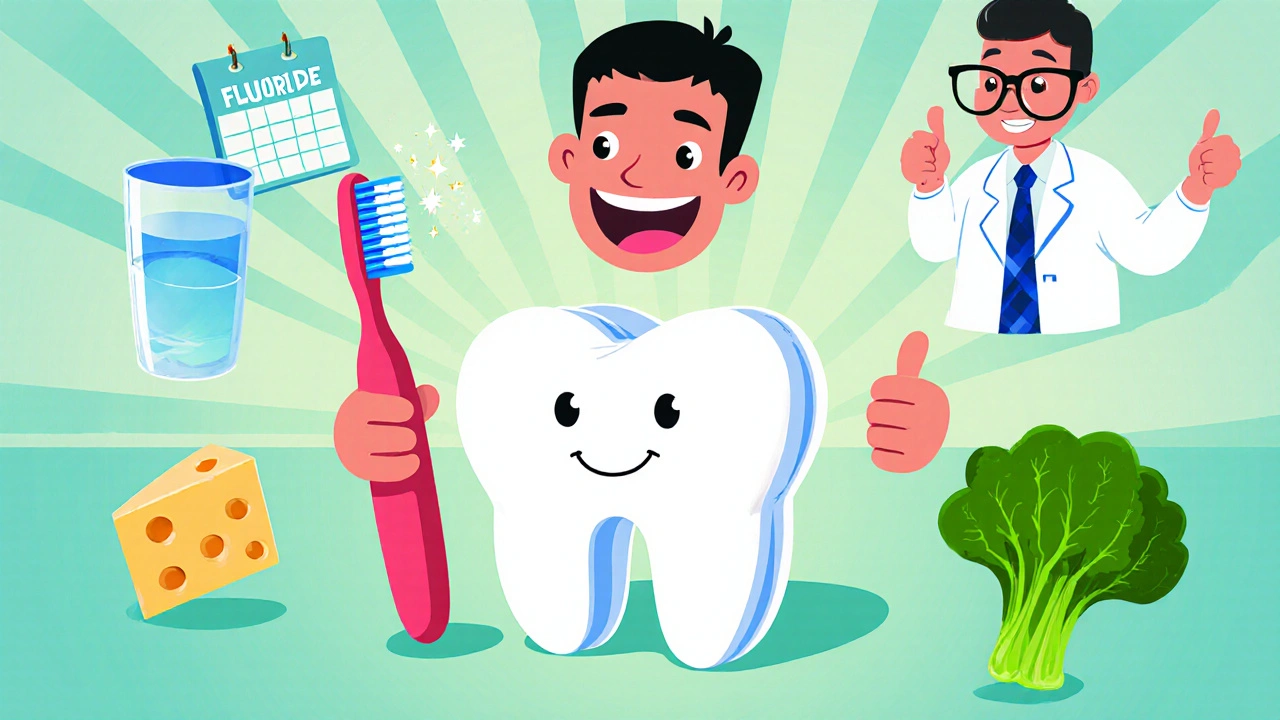Dental Risk Assessment Tool
Assess Your Dental Health Risk
This tool calculates your risk of oral complications based on your condition and treatment. Complete the form to get personalized recommendations.
Your Risk Assessment
When a person is diagnosed with bone marrow disorders are a group of conditions that affect the production of blood cells in the bone marrow, they often wonder how it will impact the rest of their body, especially their mouth. The link between the blood‑forming system and oral health may sound surprising, but the two are tightly connected through nutrition, immunity, and the side‑effects of common treatments. This guide walks through the biology, the most frequent oral problems, and practical steps you can take to protect your smile while managing a marrow condition.
Understanding Bone Marrow Disorders
Bone marrow disorders include a wide spectrum of diseases such as aplastic anemia, myelodysplastic syndromes, leukemias, and multiple myeloma. Each disorder disrupts the marrow’s ability to produce red cells, white cells, or platelets, leading to complications like fatigue, infections, and bleeding. The severity varies: some patients experience mild cytopenias, while others require aggressive chemotherapy or stem‑cell transplantation.
Key attributes of these disorders are:
- Reduced red blood cell count (anemia) - lowers oxygen delivery to tissues.
- Low white blood cell count (leukopenia) - weakens the immune response.
- Platelet deficiency (thrombocytopenia) - increases bleeding risk, including gum bleeding.
What Is Dental Health?
Dental health refers to the condition of the teeth, gums, and supporting structures that enable chewing, speaking, and a confident smile. Good oral health relies on regular cleaning, balanced nutrition, adequate saliva, and an effective immune system to fend off bacteria.
When any of these components are compromised, problems such as cavities, periodontal disease, and oral infections can arise. Because the mouth is the gateway to the body, oral issues often signal or exacerbate systemic problems.
Physiological Links: How Marrow Problems Reach the Mouth
The connection between marrow disorders and dental health runs through three main pathways: blood supply, immune function, and treatment side‑effects.
Anemia and Tissue Oxygenation
Anemia is a common feature of many marrow diseases, reducing the amount of hemoglobin that carries oxygen. Oral tissues, especially the thin gingival epithelium, are highly sensitive to low oxygen levels. Patients often report pale gums, delayed healing after a dental procedure, and a higher susceptibility to ulcerations.
Leukopenia and Infection Risk
Leukopenia diminishes the body’s ability to fight bacterial overgrowth. The mouth hosts a complex microbiome; when immune surveillance drops, opportunistic organisms like Candida albicans can overgrow, leading to oral thrush. Even routine brushing can cause painful abrasions if the protective immune barrier is weak.
Platelet Deficiency and Bleeding
Low platelet counts make even minor gum irritation result in prolonged bleeding. This not only discourages proper flossing but also complicates dental cleanings and extractions, increasing the risk of infection.

Treatment‑Related Oral Side Effects
Chemotherapy, radiation, and stem‑cell transplantation are cornerstone therapies for many marrow disorders, yet they bring a host of oral challenges.
Chemotherapy and Mucositis
Chemotherapy attacks rapidly dividing cells, which includes the lining of the mouth. Up to 80 % of patients develop oral mucositis - painful, inflamed sores that can make eating and speaking difficult.
Severity is graded 1‑4; grade 3-4 often requires nutritional support and may delay further cancer treatment.
Radiation to the Head and Neck
When radiation is part of the treatment plan, salivary glands can be damaged, causing xerostomia (dry mouth). Saliva lubricates tissues and contains antimicrobial proteins; a dry environment fuels caries and periodontal breakdown.
Stem‑Cell Transplantation
Stem cell transplant patients undergo high‑dose chemotherapy followed by infusion of healthy marrow. The conditioning regimen often leads to prolonged neutropenia, severe mucositis, and a heightened risk of viral or fungal oral infections.
Common Dental Problems Seen in Marrow Patients
Below is a quick snapshot of oral complications most frequently reported across different marrow conditions and their typical treatments.
| Disorder / Therapy | Bleeding/Gum Issues | Infections (Candidiasis, Bacterial) | Mucositis / Ulcers | Dry Mouth / Caries |
|---|---|---|---|---|
| Aplastic Anemia (supportive care) | Common due to thrombocytopenia | Elevated fungal risk if neutropenic | Rare without chemo | Usually mild |
| Acute Leukemia (intensive chemo) | Frequent gingival bleeding | High bacterial & candida load | Severe mucositis (grade 3‑4) | Dry mouth from meds |
| Multiple Myeloma (lenalidomide + steroid) | Platelet function affected | Opportunistic infections common | Moderate mucosal irritation | Dry mouth due to salivary hypofunction |
| Stem‑Cell Transplant (high‑dose chemo) | Severe bleeding during neutropenia | Both bacterial and fungal | Profound mucositis, often lasting >2 weeks | Persistent xerostomia |

Practical Steps to Protect Your Smile
Managing oral health while navigating a bone marrow disorder requires a proactive, teamwork‑based approach. Here’s a checklist you can share with your hematology and dental teams:
- Schedule a pre‑treatment dental exam. Identify existing cavities, gum disease, or loose teeth that could become infection sources.
- Maintain gentle brushing twice daily with a soft‑bristled toothbrush. Replace the brush every 2‑3 weeks.
- Use an alcohol‑free fluoride mouth‑rinse (e.g., 0.05 % NaF) to strengthen enamel, especially if you develop dry mouth.
- Consider a prescription saliva substitute or sugar‑free chewing gum if xerostomia sets in.
- Limit sugary snacks and acidic drinks; opt for cheese, yogurt, and leafy greens that boost calcium and vitamins.
- Vitamin D‑rich foods (fatty fish, fortified milk) help bone and tooth mineralization.
- Iron‑rich foods (lean meat, beans) support red‑cell recovery.
- Report any new sore, persistent bleeding, or white patches to your care team immediately-early antifungal or antibiotic therapy can prevent serious complications.
- If you’re undergoing chemotherapy, ask about prophylactic oral care protocols (e.g., low‑level laser therapy, cryotherapy with ice chips) that can lower mucositis risk.
- Stay hydrated; sip water throughout the day to keep the oral mucosa moist.
- Coordinate timing of dental cleanings with your blood count schedule. Safe windows are usually when platelet > 50 × 10⁹/L and neutrophils > 1.0 × 10⁹/L.
Red‑Flag Symptoms That Require Immediate Attention
Even with diligent care, some issues demand urgent evaluation:
- Uncontrolled gum bleeding lasting more than 10 minutes.
- Severe ulcerations that prevent eating or drinking.
- White patches that cannot be wiped away (possible candidiasis).
- Sudden tooth mobility or loose prostheses.
- Swelling or pain that radiates to the jaw or ear (possible osteomyelitis).
Prompt treatment can prevent systemic spread and spare you from delaying life‑saving oncologic therapy.
Frequently Asked Questions
Can I get a regular dental cleaning while on chemotherapy?
Yes, but schedule it during a period when your white‑cell and platelet counts are within safe limits. Your oncologist can confirm the exact numbers, usually a platelet count above 50 × 10⁹/L and neutrophils above 1.0 × 10⁹/L.
Why do I get frequent cavities after a stem‑cell transplant?
High‑dose chemotherapy damages salivary glands, causing dry mouth. Saliva neutralizes acids and clears sugars; without it, bacteria thrive and enamel demineralizes faster. Using fluoride rinses and sipping water can mitigate the risk.
Is oral candidiasis dangerous for someone with a marrow disorder?
It can become serious because the fungus may spread to the esophagus or bloodstream, especially when neutrophils are low. Antifungal medication prescribed early usually clears the infection without complications.
Do I need a special toothbrush?
A soft‑bristled, ultra‑soft brush works best. It cleans without traumatizing fragile gums and tooth surfaces that may bleed easily.
Can diet improve my oral health during treatment?
Yes. Foods high in calcium, vitamin D, and protein support both bone marrow recovery and tooth mineralization. Avoid sticky sweets and acidic sodas that erode enamel.


Margaret pope
Hey folks this guide is a solid start for anyone wrestling with marrow issues and their smile it breaks down the tough stuff without drowning you in jargon